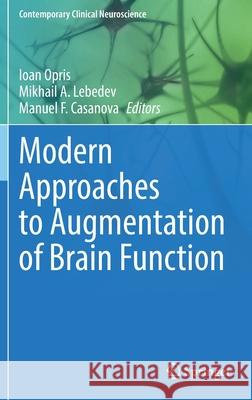Modern Approaches to Augmentation of Brain Function » książka



Modern Approaches to Augmentation of Brain Function
ISBN-13: 9783030545635 / Angielski / Twarda / 2021 / 750 str.
Modern Approaches to Augmentation of Brain Function
ISBN-13: 9783030545635 / Angielski / Twarda / 2021 / 750 str.
(netto: 883,85 VAT: 5%)
Najniższa cena z 30 dni: 886,75
ok. 22 dni roboczych
Dostawa w 2026 r.
Darmowa dostawa!
PREFACE (Ioan Opris, Mikhail Lebedev, Manuel F. Casanova)
INTRODUCTION: What is the meaning of the augmented brain function? Jon H. Kaas
Part 1: Stimulating the brain
1) Using electrical stimulation to explore and augment the functions of parietal-frontal cortical networks in primates (Jon H. Kaas and Iwona Stepniewska)
2) Multi-system benefits of epidural stimulation following spinal cord injury (Guest J. D. Chang S. Santamaria A. J., Opris I. and Noga B. R.)
3) Neurostimulator for hippocampal memory prosthesis (Sahar Elyahoodayan, Wenxuan Jiang, Huijing Xu and Dong Song
4) Modern approaches to augmenting the brain functions (Ioan Opris, Brian R. Noga Mikhail Lebedev and Manuel F. Casanova)
Part II: Brain computer interfaces
5) Brain machine interfaces within a critical perspective (Antonio G. Zippo and Gabriele E. M. Biella)
6) An implantable wireless device for ECoG and cortical stimulation (Pantaleo Romanelli)
7) BCI Performance improvement by special low jitter quasi-steady State VEP paradigm (Ibrahim Kaya, Jorge Bohorquez and Özcan Özdamar)
8) Communication with Brain-Computer Interfaces in Medical Decision-Making (Walter Glannon)
Part III: Augmenting cognitive function.
9) Neuroprotection and neurocognitive augmentation by photobiomodulation (F. Gonzalez-Lima)
10) Avoiding partial sleep - the way for augmentation of brain function (Ivan N. Pigarev and Marina L. Pigareva)
11) Augmentation of brain functions by nanotechnology (Ioan Opris, Nicholas Preza, Mikhail A. Lebedev, Brian Noga, Stephano Chang, Manuel F. Casanova, Mircea Lupusoru, Victor M. Pulgar, Sakhrat Khizroev, Jorge Bohorquez and Aurel Popescu)
12) The impact of ageing and age-related comorbidities on stroke outcome in animal models and humans (Aurel Popa-Wagner, Mircea Popescu-Driga and Daniela Glavan)
13) Diagnostic markers of sub-clinical depression based on functional connectivity (Yunkai Zhu, Jorge Bohorquez and Ioan Opris)
14) Transcranial magnetic stimulation in autism spectrum disorders: modulating brainwave abnormalities and behaviors (Manuel F. Casanova, Ioan Opris, Estate M. Sokhadze, Emily L. Casanova and Xiaoli Li)
15. Neurofeedback training with concurrent psychophysiological monitoring in children with autism spectrum disorder with comorbid attention deficit/hyperactivity disorder Sokhadze E. M., Kelly D. P., and Casanova M. F
Part IV: Futuristic approaches to augmentation
16) Augmentation through interconnection: brain-nets and telemedicine (Mikhail A. Lebedev, Igor A. Shaderkin, Ilia V. Ryabkov and Georgy S. Lebedev)
17) Cognitive augmentation via a brain/cloud interface (Angelica A., Opris IPrenume Boehm
18) Augmentation of neuro-marketing by neural technology (Qingguo Ma)
19) Augmentation of nutrition by nanotechnology (Cosmin Sonea, Mircea Lupusoru and Ioan Opris)
20) Neural spintronics: noninvasive augmentation of brain functions (Stewart E. Barnes, Ioan Opris, Brian R. Noga, Sunxiang Huang, Fulin Zuo)
Part V: Augmenting behavior
21) Does the power to suppress an action make us free? (Giovanni Mirabella)
22) Deep brain stimulation for Parkinson’s disease-future directions for enhancing motor function (Corneliu C. Luca, Joacir Graciolli Cordeiro, Iahn Cajigas and Jonathan Jagid)
23) Neuromodulation for gait (S. Chang, Ioan Opris, J. D. Guest and Brian R. Noga
24) Augmentation and rehabilitation with active orthotic devices (Gelu Onose, Maria Veronica Morcov, Corina Sporea, Andrada Mirea and Vlad Ciobanu)
Part VI: Augmenting cognition and emotion
25) Effects of rTMS on behavioral and electrocortical measures of error monitoring and correction function in children with autism spectrum disorder (Estate M. Sokhadze, Ioan Opris, Lonnie Sears, Ayman S. El-Baz, Allan Tasman and Manuel F. Casanova)
26) Affective Virtual Reality Gaming for Autism (Yi (Joy) Li, Estate M. Sokhadze, Hao (Irene) Luo, Ayman S. El-Baz and Adel S. Elmaghraby)
27) A machine learning approach to automatic phobia therapy with virtual reality (Oana Bălan, Alin Moldoveanu and Marius Leordeanu)
Part VII: Pharmacological augmentation
28) Vision augmentation by pharmacological enhancement of the visual experience (Elvire Vaucher)
29) Cognitive enhancing substances and the developing brain: risks and benefits (Kimberly R. Urban and Wen-Jun Gao)
30) Pharmacological approaches in the augmentation and recovery of brain function (Dafin F. Mureșanu, Codruța Bîrle, Livia Livinț Popa, Olivia Verișezan-Roșu and Ștefan Strilciuc)
This book covers recent advances in the neural technology that produces enhancements for brain function. It addresses a broad range of neural phenomena occurring in the brain circuits for perception, cognition, emotion and action, representing the building blocks of the behavior and mind.
Augmentation of brain function is achieved using brain implants for recordings, stimulation and drug delivery. Alternative methods include employing brain-machine interfaces, as well as noninvasive activation of certain brain areas. Existing methods of brain augmentation are evaluated, and new approaches are introduced. Brain circuitry and neuronal mechanisms that are candidates for augmentation are discussed.
This volume provides novel insights into brain disorders, and new devices for brain repair. Information in this book is relevant to researchers in the field of neuroscience, engineering, and clinical practice. Philosophical and ethical implications of brain augmentation are also addressed.
"This book employs a holistic approach in covering the recent advances in the fields of neuroscience, neuroinformatics, neurotechnology and neuro-psycho-pharmacology. Each chapter of the book covers major aspects of modern brain research in connection with the human mind and behavior, and is authored by researchers with unique expertise in their field. " – Ioan Dumitrache
“This book presents compelling perspectives on what interactive neuroscience will look like in the future, delving into the innovatory ideas of a diverse set of neuroscientists, and speculating on the different ways computer chips implanted in the brains of humans can effect intelligence and communication.” – György Buzsáki
1997-2025 DolnySlask.com Agencja Internetowa
KrainaKsiazek.PL - Księgarnia Internetowa









